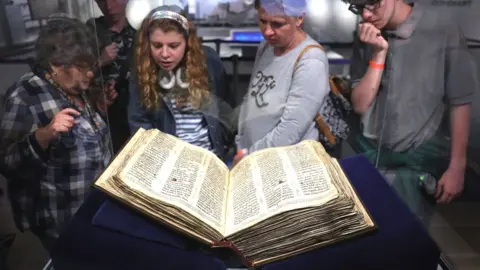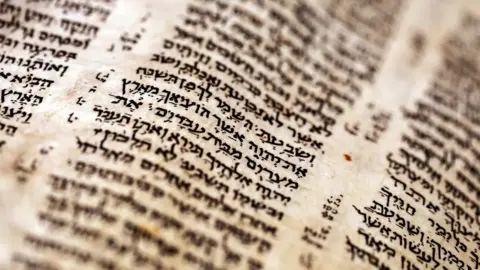Oldest most complete Hebrew Bible goes on display in Israel before sale
 EPA
EPAThe oldest most complete Hebrew Bible is on display in the Israeli city of Tel Aviv before its sale at an auction.
The Codex Sassoon is thought to have been created about 1,100 years ago by a scribe in Egypt or the Levant.
It is the earliest surviving example of a single manuscript containing all 24 books of the Hebrew Bible with punctuation, vowels, and accents.
It will go under the hammer at Sotheby's in New York in May, where it could fetch $30m to $50m (£24m-£41m).
It could become the most expensive historical document ever sold at auction if the winning bid exceeds the $43.2m paid two years ago for a rare first-edition copy of the Constitution of the United States.
The Hebrew Bible comprises 24 books divided into three parts: the Pentateuch, the Prophets, and the Writings. Christians refer to them as the Old Testament.
The text of the Hebrew Bible remained in flux until the early Middle Ages, when Jewish scholars known as Masoretes began to create a body of notes that standardised it.
The Aleppo Codex, which was assembled around 930, is considered the most authoritative Masoretic text. However, damage from a fire in the Syrian city of Aleppo in 1947 means that only 295 of the original 487 pages survive today.
The Codex Sassoon, which carbon dating shows was created around 900, is missing only 12 pages, according to Sotheby's.
"It presents to us the first time an almost-complete book of the Hebrew Bible appears with the vowel points, the cantillation and the notes on the bottom telling scribes how the correct text should be written," Sharon Mintz, senior Jewish artefact specialist at the auction house, told AFP news agency.
 Reuters
ReutersCenturies of annotations and inscriptions reveal that the manuscript was sold by a man named Khalaf ben Abraham to Isaac ben Ezekiel al-Attar, who later transferred ownership to his two sons, Ezekiel and Maimon.
In the 13th Century, the codex was dedicated to a synagogue in Makisin, in north-eastern Syria.
After the town was destroyed by either by the Mongols later in the 13th Century or by the Timurids at the start of the 15th Century, the manuscript was entrusted for safekeeping to Salama ibn Abi al-Fakhr.
It then disappeared in history for 500 years before being acquired in 1929 by David Solomon Sassoon, who assembled the largest and most important private collection of Hebrew manuscripts in the world at his home in London.
The Codex Sassoon has only been on public display once before in modern history - at the British Library in 1982.
The curator of the ANU Museum of the Jewish People in Tel Aviv, Orit Shaham Gover, said she was expecting some 10,000 visitors to attend the "rare and moving" week-long exhibition of "the first Bible that survived history".
"The Bible is the foundation of Jewish culture," she added. "As an Israeli and a Jew, I think it's very important that the people of Israel will get to see this highly important Bible."